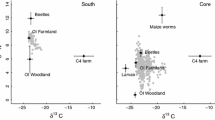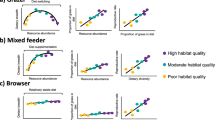Abstract
Forage abundance, forage quality, and social factors are key elements of the foraging ecology of wild herbivores. For non-ruminant equids, forage-limited environments are likely to impose severe constraints on their foraging behaviour. We used a multi-scale approach to study foraging behaviour in kiang (Equus kiang), a wild equid inhabiting the high-altitude rangelands of the Tibetan Plateau. Using behavioural observations and vegetation sampling, we first assessed how patterns of plant abundance and quality affected (i) the instantaneous forage intake rate (fine scale) and (ii) the proportion of time spent foraging (coarse scale) across seasons. We also tested whether foraging behaviour differed among group types, between sex in adults, and between females of different reproductive status. At a fine scale, intake rate increased linearly with bite size and increased following a type II curvilinear function with biomass on feeding sites. Forage intake rate also increased linearly with plant quality. Male and female kiangs had similar intake rates. Likewise, gravid and lactating females had similar intake rates as barren and non-lactating females. At a coarse scale, kiangs spent longer time feeding in mesic than in xeric habitats, and spent more time feeding in early summer and fall than in late summer. Groups of adults with foals spent less time feeding than male groups and groups of adults without foals. Our findings suggest that kiangs use flexible foraging behaviours in relation to seasonal variations of vegetation quality and abundance, a likely outcome of the extreme seasonal conditions encountered on the Tibetan Plateau.





Similar content being viewed by others
References
Albon SD, Langvatn R (1992) Plant phenology and the benefits of migration in a temperate ungulate. Oikos 65:502–513
Altmann J (1974) Observational study of behavior: sampling methods. Behaviour 49:227–267
Bailey DW, Gross JE, Laca EA, Rittenhouse LR, Coughenour MB, Swift DM, Sims PL (1996) Mechanisms that result in large herbivore grazing distribution patterns. J Range Manag 49:386–400
Berger J (1986) Wild horses of the Great Basin: social competition and population size. University of Chicago Press, Chicago
Burnham KP, Anderson DR (2002) Model selection and multimodel inference: a practical information-theoretic approach. Springer-Verlag, New York
Côté SD, Schaefer JA, Messier F (1997) Time budget and synchrony of activities in muskoxen: the influence of sex, age, and season. Can J Zool 75:1628–1635
DelGiudice GD, Mech LD, Seal US (1990) Effects of winter undernutrition on body composition and physiological profiles of white-tailed deer. J Wildl Manage 54:539–550
Demment MW, Van Soest PJ (1985) A nutritional explanation for body-size patterns of ruminants and nonruminant herbivores. Am Nat 125:641–672
Denzau G, Denzau H (1999) Wildesel. Thorbecke, Stuttgart
Duncan P (1992) Horses and grasses: the nutritional ecology of equids and their impact on the Camargue. Springer, New York
Duncan P, Foose TJ, Gordon IJ, Gakahu CG, Lloyd M (1990) Comparative nutrient extraction from forages by grazing bovids and equids: a test of the nutritional model of equid/bovid competition and coexistence. Oecologia 84:411–418
Edouard N, Fleurance G, Martin-Rosset W, Duncan P, Dulphy JP, Grange S, Baumont R, Dubroeucq H, Pérez-Barbería FJ, Gordon IJ (2008) Voluntary intake and digestibility in horses: effect of forage quality with emphasis on individual variability. Animal 2:1526–1533. doi:10.1017/S1751731108002760
Fleurance G, Fritz H, Duncan P, Gordon IJ, Edouard N, Vial C (2009) Instantaneous intake rate in horses of different body sizes: influences of sward biomass and fibrousness. Appl Anim Behav Sci 117:84–92. doi:10.1016/j.applanim.2008.11.006
Fortin D, Fryxell JM, Pilote R (2002) The temporal scale of foraging decisions in Bison. Ecology 83:970–982
Fox JL, Nurbu C, Chundawat RS (1991) The Mountain ungulates of Ladakh, India. Biol Conserv 58:167–190
Fryxell JM (1991) Forage quality and aggregation by large herbivores. Am Nat 138:478–498
Giraldeau L-A, Caraco T (2000) Social foraging theory. Princeton University Press, Princeton
Gross J, Shipley LA, Hobbs NT, Spalinger DE, Wunder BA (1993) Functional response of herbivores in food-concentrated patches: tests of a mechanistic model. Ecology 74:778–791
Hamel S, Côté SD (2007) Habitat use patterns in relation to escape terrain: are alpine ungulate females trading off better foraging sites for safety? Can J Zool 85:933–943
Hamel S, Côté SD (2008) Trade-offs in activity budget in an alpine ungulate: contrasting lactating and nonlactating females. Anim Behav 75:217–227. doi:10.1016/j.anbehav.2007.04.028
Hobbs NT, Gross JE, Shipley LA, Spalinger DE, Wunder BA (2003) Herbivore functional response in heterogeneous environments: a contest among models. Ecology 84:666–681
Illius AW (2006) Linking functional responses and foraging behaviour to population dynamics. In: Danell K, Bergström R, Duncan P, Pastor J (eds) Large herbivore ecology, ecosystem dynamics and conservation. Cambridge University Press, New York, pp 71–96
Janis C (1976) The evolutionary strategy of the equidae and the origins of rumen and caecal digestion. Evolution 30:757–774
Janis C, Ehrhardt D (1988) Correlation of relative muzzle width and relative incisor width with dietary preference in ungulates. Zool J Linn Soc 92:267–284
Jarman PJ (1974) The social organization of antelope in relation to their ecology. Behaviour 48:216–267
Kaczensky P, Ganbaatar O, von Wehrden H, Walzer C (2008) Resource selection by sympatric wild equids in the Mongolian Gobi. J Appl Ecol 45:1762–1769. doi:10.1111/j.1365-2664.2008.01565.x
Klingel H (1977) Observations on social organization and behaviour of African and Asiatic Wild Asses (Equus africanus and Equus hemionus). Zietschrift fur Tierpsychology 44:323–331
Laca EA, Ungar ED, Seligman N, Demment MW (1992) Effects of sward height and bulk density on bite dimensions of cattle grazing homogeneous swards. Grass Forage Sci 47:91–102
Laca EA, Distel RA, Griggs TC, Demment MW (1994) Effects of canopy structure on patch depression by grazers. Ecology 75:706–716
Laca EA, Shipley LA, Reid ED (2001) Structural anti-quality characteristics of range and pasture plants. J Range Manage 54:413–419
Mani MS (1978) Ecology and phytogeography of high altitude plants of the northwest Himalaya. Chapman and Hall, London
McNaughton SJ (1985) Ecology of a grazing ecosystem: the Serengeti. Ecol Monogr 55:259–294
Moen J, Andersen R, Illius A (2006) Living in a seasonal ecosystem. In: Danell K, Bergström R, Duncan P, Pastor J (eds) Large herbivore ecology, ecosystem dynamics and conservation. Cambridge University Press, New York, pp 50–70
Neuhaus P, Ruckstuhl KE (2002) The link between sexual dimorphism, activity budgets, and group cohesion: the case of the plain zebra (Equus Burchelli). Can J Zool 80:1437–1441. doi:10.1139/Z02-126
Okello MM, Wishitemi REL, Muhoro F (2002) Forage intake rates and foraging efficiency of free-ranging zebra and impala. S Afr J Wildl Res 32:93–100
Owen-Smith N (2002) Adaptive herbivore ecology. Cambridge University Press, New York
Pérez-Barbería FJ, Nores C (1996) Grazing activity of breeding and non-breeding female Cantabrian chamois (Rupicapra pyrenaica parva). Ethol Ecol Evol 8:353–363
Pérez-Barbería FJ, Pérez-Fernández E, Robertson E, Alvarez-Enríquez B (2008) Does the Jarman-Bell principle at intra-specific level explain sexual segregation in polygynous ungulates? Sex differences in forage digestibility in Soay sheep. Oecologia 157:21–30. doi:10.1007/s00442-008-1056-4
Pfister O (2004) Birds and mammals of Ladakh. Oxford University Press, New Delhi
Rawat GS, Adhikari BS (2005) Floristics and distribution of plant communities across moisture and topographic gradients in Tso Kar basin, Changthang Plateau, Eastern Ladakh. Arctic Antarctic Alpine Res 17:539–544
Rubenstein DI (1986) Ecology and sociality in horses and zebras. In: Rubenstein DI, Wrangham RW (eds) Ecological aspects of social evolution. Princeton University Press, Princeton, pp 282–302
Rubenstein DI (1989) Life history and social organization in arid adapted ungulates. J Arid Environ 17:145–156
Rubenstein DI (1994) The ecology of female social behaviour in horses, zebras, and asses. In: Jarman P, Rossiter A (eds) Animal societies: individuals, interactions and organisations. Kyoto University Press, Kyoto, pp 13–28
Ruckstuhl KE (1998) Foraging behaviour and sexual segregation in bighorn sheep. Anim Behav 56:99–106
SAS Institute Inc (2003) SAS/stat user’s guide. SAS Institute Inc, Cary
Schaefer JA, Messier F (1995) Habitat selection as a hierarchy: the spatial scales of winter foraging by muskoxen. Ecography 18:333–344
Schaller GB (1998) Wildlife of the Tibetan Steppe. The University of Chicago Press, Chicago
Shipley LA (2007) The influence of bite size on foraging at larger spatial and temporal scales by mammalian herbivores. Oikos 116:1964–1974. doi:10.1111/j.2007.0030-1299.15974.x
Shrader AM, Owen-Smith N, Ogutu JO (2006) How a mega-grazer copes with the dry season: food and nutrient intake rates by white rhinoceros in the wild. Funct Ecol 20:376–384
Spalinger DE, Hobbs NT (1992) Mechanisms of foraging in mammalian herbivores: new models of functional response. Am Nat 140:325–348
SPSS Inc (2002) SigmaPlot 8.0 user’s guide. SPSS Inc, Chicago
Stephens DW, Krebs JR (1986) Foraging theory. Princeton University Press, Princeton
St-Louis A (2010) Écologie du kiang au Ladakh: sélection des ressources, approvisionnement et comportement social d’un équidé méconnu du plateau tibétain. PhD dissertation, Department of Biology, Laval University, Québec, Québec, Canada
St-Louis A, Côté SD (2009) Equus kiang (Perissodactyla: Equidae). Mammalian Species 835:1–11. doi:10.1644/835.1
Sundaresan SR, Fischhoff IR, Duschhoff J, Rubenstein DI (2007) Network metrics reveal differences in social organization between two fission-fusion species, Grevy’s zebra and onager. Oecologia 151:140–149. doi:10.1007/s00442-006-0553-6
Therrien J-F, Côté SD, Festa-Bianchet M (2007) Conservative maternal care in an iteroparous mammal: a resource allocation experiment. Behav Ecol Sociobiol 62:193–199
Twine W (2002) Feeding time budgets of selected African ruminant and non-ruminant grazers. Afr J Ecol 40:410–412
Van der Wal R, Madan N, Van Lieshout S, Dormann C, Langvatn R, Albon SD (2000) Trading forage quality for quantity? Plant phenology and patch choice by Svalbard reindeer. Oecologia 123:108–115
Van Soest PJ (1994) Nutritional ecology of the ruminant, vol 2nd. Cornell University Press, Ithaca
Van Soest PJ (1996) Allometry and ecology of feeding behavior and digestive capacity in herbivores: a review. Zoo Biol 15:455–479
Wilmshurst JF, Fryxell JM, Farm BP, Sinclair ARE, Henschel CP (1999) Spatial distribution of Serengeti wildebeest in relation to resources. Can J Zool 77:1223–1232
Wilmshurst JF, Fryxell JM, Bergman CM (2000) The allometry of patch selection in ruminants. Proc Royal Soc London B 267:345–349
Xu RH (2003) Measuring explained variation in linear mixed effects models. Stat Med 22:3527–3541. doi:10.1002/sim.1572
Acknowledgments
Our research was funded by the Wildlife Conservation Society, the Natural Sciences and Engineering Research Council of Canada and the Bureau International de l’Université Laval, Canada. We thank K. Gailson, S. Tsering, C. Namgyal, J. Namgyal and the Rupshu nomadic community for their invaluable help in the field. We also thank J.L. Fox (University of Tromsø), S. Sathyakumar (Wildlife Institute of India), S. Ul-Haaq, J. Thakpa (Department of Wildlife Protection of Jammu and Kashmir) and the Norwegian Agency for Development Cooperation (WII-UiTø ICP programme) for their logistical support. We are indebted to D.I. Rubenstein, D. Fortin, C. Dussault, J. Pastor and an anonymous reviewer for insightful comments on a previous version of the manuscript. Finally, we thank J. Mainguy, S. Hamel and A. Massé for their help with statistical analyses.
Author information
Authors and Affiliations
Corresponding author
Additional information
Communicated by Gøran Ericsson.
Electronic supplementary material
Below is the link to the electronic supplementary material.
Rights and permissions
About this article
Cite this article
St-Louis, A., Côté, S.D. Foraging behaviour at multiple temporal scales in a wild alpine equid. Oecologia 169, 167–176 (2012). https://doi.org/10.1007/s00442-011-2166-y
Received:
Accepted:
Published:
Issue Date:
DOI: https://doi.org/10.1007/s00442-011-2166-y




